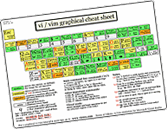[I sent this email out last week to all current ViEmu and Codekana users, announcing the latest releases and outlining my plans for the near future. If you didn’t receive it but would like to receive future ones (they are few and far between), drop me a line. — Jon]
Hello everyone,
It’s a long time I hadn’t sent out an email to all ViEmu and Codekana customers. Finally, new versions of all the ViEmus are ready, and I thought this would warrant an email. The new versions are 2.2 for Visual Studio, 2.2 for SQL Server too, and 1.5 for Word&Outlook, and you can download them straight from the web site front page
(http://www.viemu.com), or from the links below:
ViEmu/Visual Studio — http://www.viemu.com/ViEmuVS-2.2.6.msi
ViEmu/SQL Server — http://www.viemu.com/ViEmuSQL-2.2.6.msi
ViEmu/Word&Outlook — http://www.viemu.com/ViEmuWO-1.5.1.msi
You don’t need to uninstall your current version before installing these ones, they will automatically upgrade any previous installation. By the way, I’ve revamped the build system, and now even minor revisions (of the form 2.2.x) include automatic upgrading. No more manual uninstalling necessary for any revision.
These builds have been tested over the last few weeks by hundreds of people now (it’s been the official download from the home page for over two weeks), so they are very reliable and should not cause any trouble. Just drop me a line if anything acts up.
The major new features are i’/a’/i”/a” text-object motions that allow you to operate on strings, gt/gT to navigate tabs, gp/gP for variations on regular pasting, and several more minor points. Also very important, these versions consolidate all fixes and improvements from 2.1.0 to 2.1.27 revisions in the VS/SQL line, and 1.0.1 to 1.0.25 revisions in the Word&Outlook line. You can check all changes in the release notes:
ViEmu/VS 2.2 — http://www.viemu.com/viemu-vs-22-release-notes.html
ViEmu/SQL 2.2 — http://www.viemu.com/viemu-sql-22-release-notes.html
ViEmu/W&O 1.5 — http://www.viemu.com/viemu-wo-15-release-notes.html
In the past few months, I have set up two new blogs, one ViEmu-specific and the other one Codekana-specific, where I post about every little improvement and minor revision. If you are a regular ViEmu and/or Codekana user, you can subscribe in order to stay informed of the latest news on each product:
http://www.viemu.com/blog/
http://www.codekana.com/blog/
This is nicer than sending out emails for every little change, and still allows me to communicate improvements efficiently to those interested.
I thought I’d also detail my plans for the near- to mid-term future, so that you know what ViEmu and Codekana are up to.
First thing, I will be concentrating in Codekana development for some time. I’d like to implement some new features, improve the website, and release a new 1.5 version of this product, which I want to turn into an
indispensable tool for serious development with Visual Studio in the mid-term. There’s a lot of work ahead, but there are many exciting features that are waiting in the roster.
After this is ready, I plan to work in ViEmu versions 2.5 for VS and SQL Server, and 2.0 for Word&Outlook. These versions will implement a new licensing system, mainly due to pirate key-generators being widely available out there, and installing them will require you to log in to a new customer area and download a new license key. I want to provide a nice line-up of features that will make the upgrade well worth the hassle of downloading the key. Codekana will also see some similar treatment.
Finally, ViEmu 3 is the next goal, for which there are many very useful and interesting features planned. The major new feature I want to provide is scriptability. Even in the vi/vim editing world, there are many small variations on how different people want their vi to behave, and often it just doesn’t make sense for me to implement every little variant. A scripting system will allow customization to your own taste, and allow everyone to improve it. I plan to offer some way for people to share scripts and that will also make it a much more valuable tool. The scripting language will be a javascript-like little language. I considered other options too: VS’s internal scripting, which I don’t want to use as it wouldn’t work in SQL Server, Word and Outlook, and other possible hosts; vim’s viml scripting language, which is very complex and I really dislike; and Python, which would be nice, but would make me use the Python interpreter — this would add complexity I don’t want to have in a tightly-controlled C++ codebase.
It’s also my plan to make ViEmu 3 the first version to carry a small upgrade fee for those who bought over a year before its release. This won’t be more than a small fraction of the full license price, and I want this version to provide plenty of value so that it will justify the extra fee. If not interested in the new features, you will of course be able to keep on using ViEmu 2 for as long as you want.
I’ve also been slowly advancing in the research of the technology that will power my yet-to-be-released, stand-alone text editor, Kodumi, and which will also see its way into Codekana and possibly ViEmu. This is a mid- to long-term effort, involving a completely new programming language and VM, but I hope the results will really pay off in the end. I’ll keep you updated when there are any news.
All in all, there are a lot of exciting improvements ahead, and I hope that you will find ViEmu and Codekana more and more useful in your day-to-day work as I can implement more and better features.
As always, I will be glad to hear any feedback, suggestions, bug-reports, or your thoughts about anything else. Feel free to drop me a line.
Thanks and best regards,
Jon
NGEDIT Software






